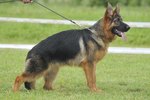The Weimaraner is known for his sleek and shimmery gray coat and his exuberant personality. His eyes may be gray, blue-gray or amber, and his gaze is engaging. His eyes are prone to some ocular health problems that Weimaraner owners should be aware of.
Entropion
Entropion occurs when the eyelid rolls inward, allowing the eyelashes to make physical contact with the cornea and cause irritation. If the irritation continues without treatment, painful corneal ulceration will result. Entropion can occur in the upper or lower eyelid, and it can affect one eye or both. It is usually observed within a dog's first year of life.
A group of genes is responsible for the formation of the eyes and their surrounding structures, including the eyelids, the amount of facial tissue around the eyes and the size and shape of the eyes and their orbits. Hereditary entropion can occur if any one of these aspects does not develop just so and the eyelids are not properly anchored in their correct position. Some signs of entropion include:
- Squinting or blinking.
- Yellow, white or green ocular discharge.
- Excessive tearing.
- Pawing at the eye.
- Ocular inflammation.
Once your veterinarian has diagnosed entropion through a physical examination of your Weimaraner's eye, his initial goals will be to prevent secondary eye infection and to treat the eye if corneal ulceration has occurred. These goals are accomplished with the use of ophthalmological medication and, if your dog is persistently pawing or rubbing his eye, an Elizabethan collar. Surgically tacking the eyelids in place is another treatment alternative in some cases.
Distichiasis
One of the most common congenital ocular conditions, distichiasis, occurs when extra eyelash hairs grow out of one of the glands of the eye, called the meibomian gland, and cause irritation on the cornea. Distichiasis usually presents in dogs under 3 years of age. As in the case of entropion, untreated distichiasis results in corneal ulceration. Signs that your Weimaraner may have distichiasis include squinting or blinking, and excessive tearing.
Treatment for distichiasis involves destroying the follicles of the extra hairs so that regrowth does not occur. The veterinarian will employ one of three methods to accomplish this: electrolysis, surgical removal or cryosurgery, which freezes the follicles at the margin from which they are growing.
Progressive Retinal Atrophy
The degenerative condition called progressive retinal atrophy is genetic. It occurs when the light receptors of the retina start to degenerate prematurely. Once the progressive disease advances, the result of progressive retinal atrophy is blindness. No pain is associated with this condition. Signs of progressive retinal atrophy include:
- Reluctance to go outdoors at night or to move around indoors during hours of darkness.
- Pupillary enlargement.
- Gradually diminishing vision during daylight hours.
- Cataract formation.
Progressive retinal atrophy can be diagnosed through an eye examination that includes an electroretinography, which evaluates the retinal function. Unfortunately, progressive retinal atrophy cannot be treated. You may take some solace in the fact that blind dogs fare well in their familiar surroundings. You will need to refrain from rearranging furniture and to be diligent in your efforts to prevent your dog from escaping his yard.
Nictitating Membrane Abnormalities
Your dog's third, or inner, eyelid is called the nictitating membrane. Two abnormalities that present in the nictitating membrane can affect Weimaraners:
- Cherry eye, in which the tear gland prolapses and appears as a reddened bulge at the corner of the dog's eye.
- Eversion of the nictitating membrane's cartilage, in which the cartilage curls outward from the dog's eye.
These abnormalities are inherited conditions. Both conditions are easily diagnosed through a physical examination of the eyes, and both conditions are treated through corrective surgery. If either of these conditions remains untreated, dry eye will result.
Corneal Dystrophy
Three types of the genetic ocular disease corneal distrophy occur. The three types are called epithelial, endothelial and stromal. They all refer to a structural abnormality or degeneration of the cornea or corneal lining. Corneal dystrophy can occur at any age and typically affects both eyes. The disease presents as opaque, or cloudy, areas on the eyes. These opaque areas are actually mineral deposits of either cholesterol or calcium. Additional signs that may be observed include:
- Corneal spasms.
- Swelling of the cornea.
- Some visual impairment, in advanced cases.
Although corneal dystrophy may appear unsightly, the condition itself rarely causes total blindness. If you observe symptoms, have your veterinarian conduct an examination of your dog's eyes. The examination will include a fluorescein dye test, in which a fluorescing dye is placed on the dog's eyes and the corneas examined with a blue light to detect ulcerations. Other tests include the use of a tonometer, which evaluates the ocular pressure of the eyes and rules out the presence of glaucoma, and the use of slit lamp microscopy, which can help to determine the type of corneal dystrophy affecting your dog. Your veterinarian may refer your Weimaraner to a board-certified veterinary ophthalmologist for further evaluation or treatment. Some treatment options include:
- Topical ophthalmological medications.
- Dietary management to lower cholesterol levels.
- Topical acid dissolution of the mineral deposits on the cornea.
- Surgical intervention to remove the outer layer of the cornea. This procedure is called a keratectomy.
If you are considering the addition of a Weimaraner puppy to your household, speak with the breeder about all of these genetic eye conditions. A reputable breeder will not breed dogs who have presented any of these conditions, and he will be happy to discuss the health history of the puppy's parents.





